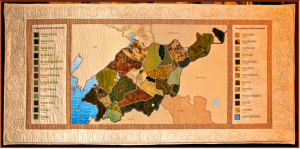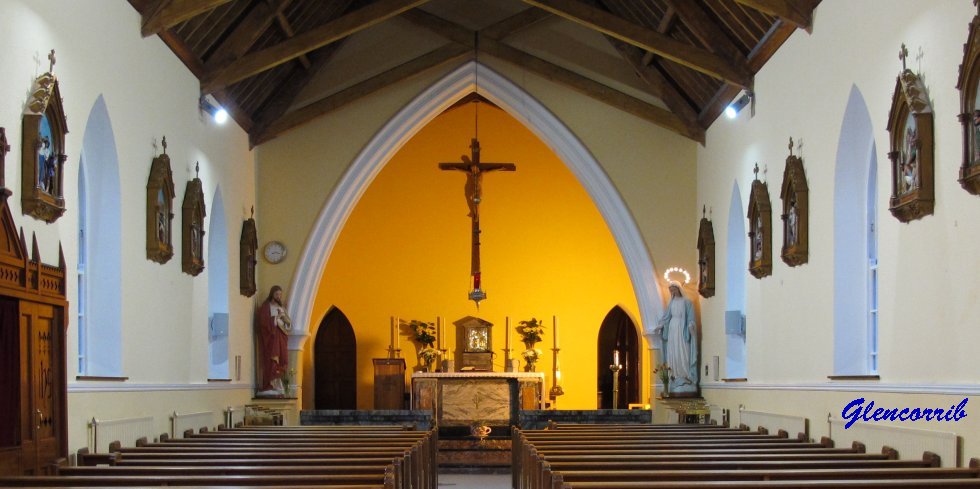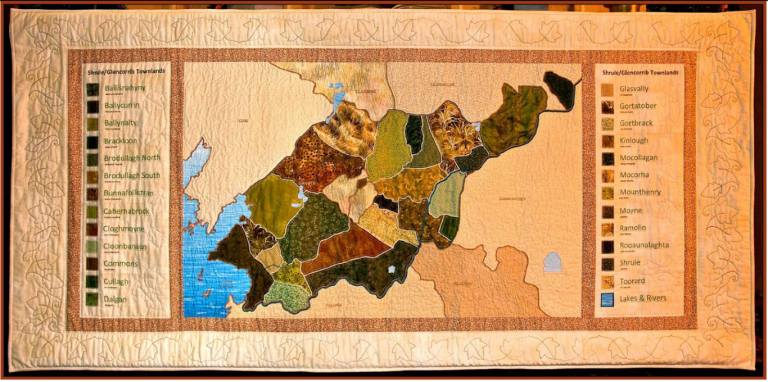Glencorrib Altar Quilt
The Glencorrib Altar Quilt was skilfully made and generously donated by members of the Glencorrib Craft Group.
 Fr. Michael Crosby (Parish Priest of Glencorrib 2006-2015) envisaged an Altar Antependium displaying the Shrule Parish Map.
Fr. Michael Crosby (Parish Priest of Glencorrib 2006-2015) envisaged an Altar Antependium displaying the Shrule Parish Map.
The Glencorrib Craft Group (Oct 2010-May 2014), a voluntary group of local people, interested in sharing craft ideas, met weekly in the Glencorrib Community Centre. In January 2013 Fr. Michael outlined his antependium idea to Craft Group members and from there the members set about making Fr. Michael’s idea a reality.
It took over a year to research, piece, applique, print, hand and machine sew the Altar Quilt.
The Altar Quilt is essentially a heritage piece, a replica in cloth of the actual Shrule Parish Map. It provides a ‘snapshot’ of the Shrule/Glencorrib Parish townlands and villages at a point in time, valuable information to be handed on from generation to generation.
It tells us that Shrule Parish is an ‘Island’ Parish, a piece of the Galway diocese oddly located in the middle of the Tuam Diocese.
Hand-sewn crosses mark the locations of the two churches (Shrule & Glencorrib) within the parish.
Our parish is a parish of 25 irregularly shaped townlands adjoining Lough Corrib and other parishes of the Tuam Diocese. Two townlands, trapped in the middle of our parish, belong to the parish of Kilmainebeg (i.e. Ballisnahyny East & Carrowoughteragh) and our townland of Brackloon is floating out there in the parish of Kilmainemore!
On the Altar Quilt each townland is identified by its own unique material and corresponding Irish and English placename. Before being printed onto cloth, each placename was verified with personnel from the Placenames Database of Ireland (logainm.ie). For information on your specific townland or village placename spelling/meaning check out the poster hanging over the candleabra.
Sincere thanks to:
Glencorrib Craft Group members who gave so generously of their time, materials, sewing and research skills in the making of the GLENCORRIB ALTAR QUILT
and
Fr. Michael Crosby for his vision and determination to gift such an educational and historical piece to the people of Glencorrib.
TOWNLAND & VILLAGE PLACENAMES
| Townland English Spelling (Ref: LOGAINM.IE ) | Townland Irish Spelling (Ref: LOGAINM.IE ) | Townland Meaning (Ref: LOGAINM.IE ) | Villages in Townland |
BALLISNAHYNY |
Baile Lis na hEidhní | the townland of the ring-fort of the place of ivy | Pollbee, Cathair Ard |
| BALLYCURRIN DEMESNE | Baile an Choirrín | the townland of the little round hill | Parks |
| BALLYNALTY | Baile an Alltaigh | the townland of the —The meaning of the final element alltach is unclear here. It may mean ‘rugged place’, referring to one of the patches of rocky or hilly land in the townland. |
Wallpark, Old Ballynalty, New Ballynalty |
| BRACKLOON | Breac-chluain | speckled pasture | |
| BRODULLAGH NORTH | Bródalach Thuaidh | Meaning unclear. | Tobar Ciaráin |
| BRODULLAGH SOUTH | Bródalach Theas | Meaning unclear. | Bothair Bui |
| BUNNAFOLLISTRAN | Muine Feileastran | thicket of (the) iris – Alternation between initial Mun- and Bun- is not uncommon in anglicization of Irish placenames (cf. Muine Chonalláin > Bonniconlan in Mayo; Bun Doilithe > Mundellihy in Limerick, etc.). |
Glencorrib, Ravenhill, Woodpark |
| CAHERNABROCK | Cathair na mBroc | the stone ring-fort of the badgers | |
| CLOGHMOYNE | Cloch Mhaighne | the stone (structure)/stony area (?) of Maighin ( Maighin – the name of the adjacent townland to the south) | Kilroe Hill, Graffee |
| CLOONBANAUN | Cluain Beannáin | the pasture of Beannán – The second element is more likely to represent the personal name Beannán than the common noun beannán, a diminutive of beann, ‘peak’. |
Longhill, Cnocfada |
| COMMONS | An tImreas | the (area in) dispute | |
| CULLAGH | An Choilleach | the wooded place | |
| DALGAN DEMESNE | Dealgain | The meaning of dealgain (dative case < dealga, ‘thorn; pin; spike’) in uncertain here; it may be used in the figurative sense ‘thorny place’ | Clochmhor, Pollachapall, Meelis, Carheen |
| GLASVALLY | An Glasbhaile | the green townland | |
| GORTATOBER | Gort an Tobair | the field of the well | |
| GORTBRACK | An Gort Breac | the speckled field | Corrinreedra |
| KINLOUGH | Cionn Locha | head(land) of (the) lake | Alacha |
| MOCOLLAGAN | Maigh Chalgaigh | the thorny plain | |
| MOCORHA | Maigh Chartha | plain of (the) standing stone – The standing stone in question is Cloch Ghort an Liagáin, ‘the stone of Gort an Liagáin’, in the north of the townland. Gort an Liagáin itself means ‘the field of the standing stone’! |
Tobar Searbh, Woodpark, Gort an Liagáin |
| MOUNTHENRY | Moin Anraí | Kilroe | |
| MOYNE | Maighin | homestead ; land around the seat of an eminent person, ecclesiastical sanctuary | Boula , Rostaff |
| RAMOLIN | Ráth Moling | the ring-fort of Moling (Moling — saint’s name). | Churchfield, Churchpark, Scaurdaun, Lakefield, St. Mary’s Road, De Clifford St |
| ROOAUNALAGHTA | Ruán an Leachta | the red place of the grave(-mound), monument | |
| SHRULE | Sruthair | stream – The sound change from final [r] to [l] is common throughout the country in this word. | |
| TOORARD | An Tuar Ard | the high animal-enclosure |
‘Our Parish’ Altar Quilt
From Glencorrib Parish Newsletter, Sunday 9th March 2014
The latest creative addition to Glencorrib’s Church of the Immaculate Conception is an Altar Quilt showing the map of Shrule Parish. The altar quilt proudly takes its place alongside other locally created pieces including homemade altar chairs, a pottery cruet set, a pair of stone candle holders & the exquisite Noah’s Ark and Rainbow.
The idea to place cloth maps on both the Shrule and Glencorrib church altars was yet another brainchild of Fr. Michael Crosby, P.P. However, the actual making of the cloths fell to the skilled hands of local women Mary O’Grady, Nuala McHugh and Teresa Fahey (Glencorrib Altar Quilt) and to Monica Murphy (Shrule Altar Cloth) with support and encouragement from other locals and members of the Glencorrib Craft Group. The accuracy and authenticity of the maps and placename spellings on which the quilt was based is thanks to information provided by local people and contained in the shrule.com and logainm.ie websites. As always great credit is due to everyone associated with the upkeep of Glencorrib/Kilroe Community Centre and Glencorrib Church for continuing to provide comfortable environments for craft work and craft appreciation.
Putting a map onto cloth posed many challenges given that the person with the idea didn’t know anything about sewing and the people doing the sewing work had never before worked with such an unusual shape; A parish of 25 irregular townlands, (surrounded by Lough Corrib and other parishes) with 2 townlands trapped in the middle belonging to Kilmainebeg(i.e. Ballisnahyny East & Carrowoughteragh) and the townland of Brackloon floating out into Kilmainemore!
Respecting the unique character of each townland, 25 individual rust/green cotton materials were selected and used in the making of the map at the centre of the quilt. The overall quilt design is intended to fit with the colourscheme of the church and its setting amidst a beautiful landscape of rivers, lakes, fields and farms. Townlands are listed in alphabetical order on the side panels, each townland clearly associated with its unique material and its original Irish placename spelling. (See also the Placenames Poster in the church). Townland placename spellings and meanings were verified with experts from An Brainse Logainmneacha (The Placenames Branch), An Roinn Ealaíon, Oidhreachta, & Gaeltachta and were re-checked thoroughly by Mary McNally before being printed onto cloth.
In his homily last weekend Fr. Crosby posed the question one Irish person will ask another no matter where they meet in the world i.e. “Where are you from?” We proudly claimed Glencorrib as home when our innovative Mayo signs and banners featured on national TV last year. This map is ‘made by local people” and “dedicated to the people of the villages and townlands around Glencorrib”. Take a few minutes to find your home, village or townland.
“To be, we need to be home.
When a place to belong to is assured,
the adventure of growth can begin with great promise.”
(Quote from Benedictus, by John O’Donohue)
Thanks to Teresa Fahy for the articles and Liam Donohue for the photographs

